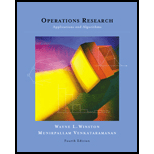
Explanation of Solution
Given:
- The total cost of employing a teller at a bank is $100 per day.
- A teller can serve an average of 60 customers per day.
- An average of 50 customers per day arrives at the bank.
- Both service times and inter arrival times are exponential.
- The delay cost per customer day is $100.
To determine
The number of tellers that the bank should hire is to be determined.
Calculating the number of tellers, the bank should hire:
The queuing system is a
Here,
Arrival rate,
Service rate,
Also, if there are s servers, then,
In queuing optimization problem, the component of cost due to customers waiting in line is referred to as the delay cost. Thus, the bank wants to minimize,
Since, the total cost of employing a tell at a bank is $100 per day, then,
Case 1:
For number of servers,
The Hourly delay cost is defined as follows:
Now, the delay cost per customer day is
Also,
Hence,
Now, the average hours the customer spends in the system
Substituting
Now, substitute the value obtained from equation 2 and equation 4 in equation 1,
Hence, the total cost per day for one server is
Case 2:
For number of servers,
Trending nowThis is a popular solution!

Chapter 20 Solutions
Operations Research : Applications and Algorithms
- A local café has a single cash register, with a single assistant to work it, and three servers working to fill the customer orders. Customers arrive with exponential interarrival time an average of one every 2 minutes. The time to place their order and pay at the register is normally distributed with mean 90 seconds and standard deviation 20 seconds. Each customer’s order is then passed to one of the servers who take on average 5 minutes with standard deviation 1.5 minutes, also normally distributed, to fill the order. a.) Calculate the capacity of the register and the servers. What is the bottleneck in this system? b.) Calculate the average utilizations of the register and the servers c.) What is the probability a customer is delayed at the register? d.) What is the expected time from a customer’s arrival to the order being passed on to the servers (including any queueing time)? e.) Estimate the probability that there is a delay between a customer placing his order and a server…arrow_forwardA local café has a single cash register, with a single assistant to work it, and three servers working to fill the customer orders. Customers arrive with exponential interarrival time an average of one every 2 minutes. The time to place their order and pay at the register is normally distributed with mean 90 seconds and standard deviation 20 seconds. Each customer’s order is then passed to one of the servers who take on average 5 minutes with standard deviation 1.5 minutes, also normally distributed, to fill the order. a.) Calculate the capacity of the register and the servers. What is the bottleneck in this system? b.) Calculate the average utilizations of the register and the servers c.) What is the probability a customer is delayed at the register?arrow_forwardthat range from 1 to 8 minutes apart. Assuming that the inter-arrival times are integer-valued with each of the 8 values having equal probability, following uniform distribution. The service times vary from 1 to 6 minutes (integer) with the probabilities given in the following table: Service time (in mins) Probability 1 0.10 2 0.20 3 0.30 4 0.25 5 0.10 6 0.05 The random numbers for inter-arrival time are: 913, 727, 015, 948, 309, 922, 753, 235, 302. The random numbers for service time are: 84, 10, 74, 53, 17, 79, 91, 67, 89, 38. As a student of AIT, use your knowledge in computer simulation and help Mr. Owusu to: a) Simulate the system for 10 customers and compute waiting time of customers, total time spent by a customer in the system and idle time of the server. b) i. Explain average waiting time and compute it ii. Explain average time spent in the system and compute it. c) i. Evaluate the probability of idle server ii.…arrow_forward
- Consider a web-server that receives web requests at an average rate ? of 20 requestsper second that follows a Poisson distribution. Answer the following questions:(a) What's the probability that it would receive 1000 requests in a minute? (b) What's the probability that no requests will arrive for 3 seconds? (c) Consider one second and assume that 20 requests already arrived in 0.5 second, whatis the probability that 20 requests will arrive in the next 0.5 seconds? (d) If you found out that the web-server was 70% of the time busy on average, what wouldbe its average service rate?arrow_forward(Please Solve problem by using your hand calculation and R). Suppose that X is the downloading time a movie, which follows a uniform distribution between 16 and 22 minutes. Let’s assume you want to download a movie. What is the probability that the download time will be (a) Less than 19 minutes? (b) More than 23 minutes? (c) Between 20 and 22 minutes? (d) What are the mean and standard deviation of the download times?arrow_forward
 Operations Research : Applications and AlgorithmsComputer ScienceISBN:9780534380588Author:Wayne L. WinstonPublisher:Brooks Cole
Operations Research : Applications and AlgorithmsComputer ScienceISBN:9780534380588Author:Wayne L. WinstonPublisher:Brooks Cole
